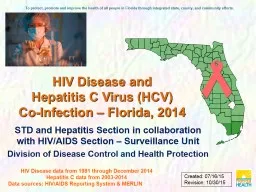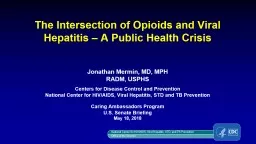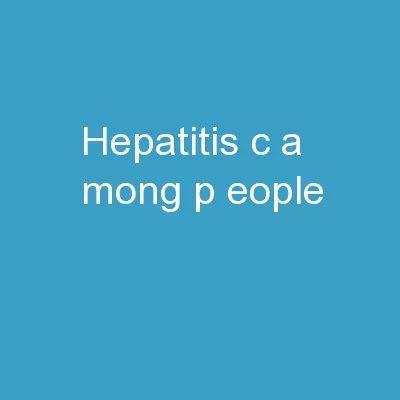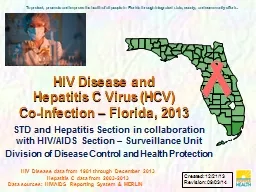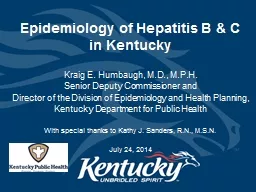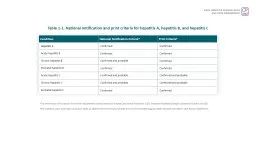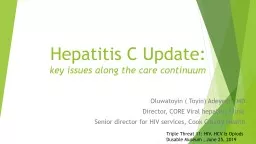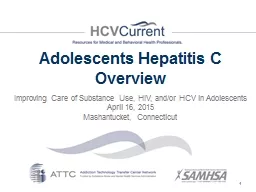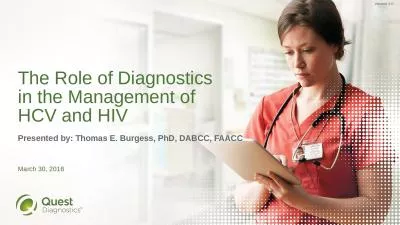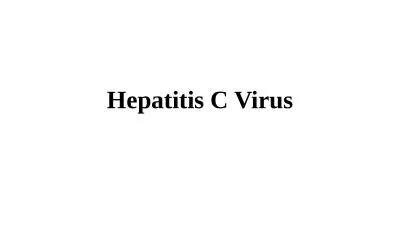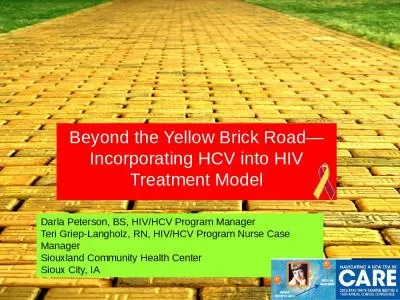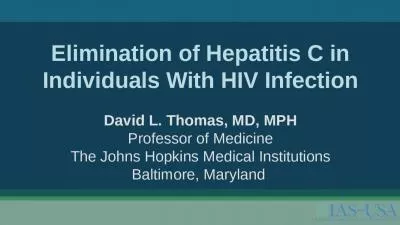PPT-HIV Disease and Hepatitis C Virus (HCV)
Author : test | Published Date : 2018-11-21
CoInfection Florida 2014 STD and Hepatitis Section in collaboration with HIVAIDS Section Surveillance Unit Division of Disease Control and Health Protection
Presentation Embed Code
Download Presentation
Download Presentation The PPT/PDF document "HIV Disease and Hepatitis C Virus (HCV)" is the property of its rightful owner. Permission is granted to download and print the materials on this website for personal, non-commercial use only, and to display it on your personal computer provided you do not modify the materials and that you retain all copyright notices contained in the materials. By downloading content from our website, you accept the terms of this agreement.
HIV Disease and Hepatitis C Virus (HCV): Transcript
CoInfection Florida 2014 STD and Hepatitis Section in collaboration with HIVAIDS Section Surveillance Unit Division of Disease Control and Health Protection HIV Disease data from 1981 through December . An Evolving Epidemic. Marina B. Klein, MD, MSc, FRCP(C). Division of Infectious Diseases and Chronic Viral Illness Service. McGill University Health Centre. HCV Genotype. Genotypes 1-6. 62% genotype 1 in Canada. Jonathan Mermin, MD, MPH. RADM, USPHS. Centers for Disease Control and Prevention. National Center for HIV/AIDS, Viral Hepatitis, STD and TB Prevention. Caring Ambassadors Program . U.S. Senate Briefing. w. ho . i. nject . d. rugs (PWID) in India: . High burden but limited access to care. . Shruti H. Mehta, PhD MPH. Professor, Johns Hopkins Bloomberg School of Public Health. Department of Epidemiology. Co-Infection – Florida, . 2013. . STD and Hepatitis Section in collaboration with HIV/AIDS Section – Surveillance Unit . Division of Disease Control and Health Protection. HIV Disease data from 1981 through December . Epidemiology of Hepatitis B & C in Kentucky Kraig E. Humbaugh , M.D., M.P.H. Senior Deputy Commissioner and Director of the Division of Epidemiology and Health Planning, Kentucky Department for Public Condition. National Notification Criteria*. Print Criteria†. Hepatitis. . A. Confirmed. Confirmed. Acute . hepatitis. . B. Confirmed. Confirmed. Chronic . hepatitis. . B. Confirmed. . and. . probable. HIV1 and slower to progress to AIDS.. Most cases are due to type1.. Modes of transmission. 1-sexual.. 2- perinatal.. 3-parenteral(occupational and intravenous drug injection).. 4- blood transfusion.. Oluwatoyin ( . Toyin. ) Adeyemi, MD. Director, CORE Viral hepatitis Clinic. Senior director for HIV services, Cook County Health . Triple Threat 11: HIV, HCV & . Opiods. Dusable. Museum , June 25, 2019. Improving Care of Substance Use, HIV, and/or HCV in Adolescents. April 16, 2015. Mashantucket, Connecticut . 1. Adolescents and HCV. Younger IDUs tend to have higher levels of unsafe injection practices and sexual risk behaviors and decreased likelihood to participate in drug treatment than their older counterparts. . National Guidelines for Diagnosis & Management of Viral Hepatitis National Guidelines for PrefaceViral hepatitis is increasingly being recognized as a public health problem in India. While hepatitis A Presented by: Thomas E. Burgess, PhD, DABCC, FAACC. March 30, 2018. Version 2.0. Hepatitis C Virus. Hepatitis C virus. (. HCV. ) is a small (55–65 . nm. in size) virus. The hepatitis C virus belongs to the genus . . . Flaviviridae. Genera; . Hepacivirus. Enveloped . virion. . Nucleocapsid. (+) . ss. RNA.. . It has no . virion. polymerase. .. Six genotypes.. . . HCV genotypes. The . genetic variability is due to the high . Teri Griep-Langholz, RN, HIV/HCV Program Nurse Case Manager. Siouxland Community Health Center. Sioux City, IA . Beyond the Yellow Brick Road—Incorporating HCV into HIV Treatment Model. Learning Objectives. David L. Thomas, MD, MPH. Professor of Medicine. The Johns Hopkins Medical Institutions. Baltimore, Maryland . Financial Relationships With Commercial Entities. Dr Thomas has no relevant financial affiliations to disclose. (Updated 11/12/18).
Download Document
Here is the link to download the presentation.
"HIV Disease and Hepatitis C Virus (HCV)"The content belongs to its owner. You may download and print it for personal use, without modification, and keep all copyright notices. By downloading, you agree to these terms.
Related Documents

